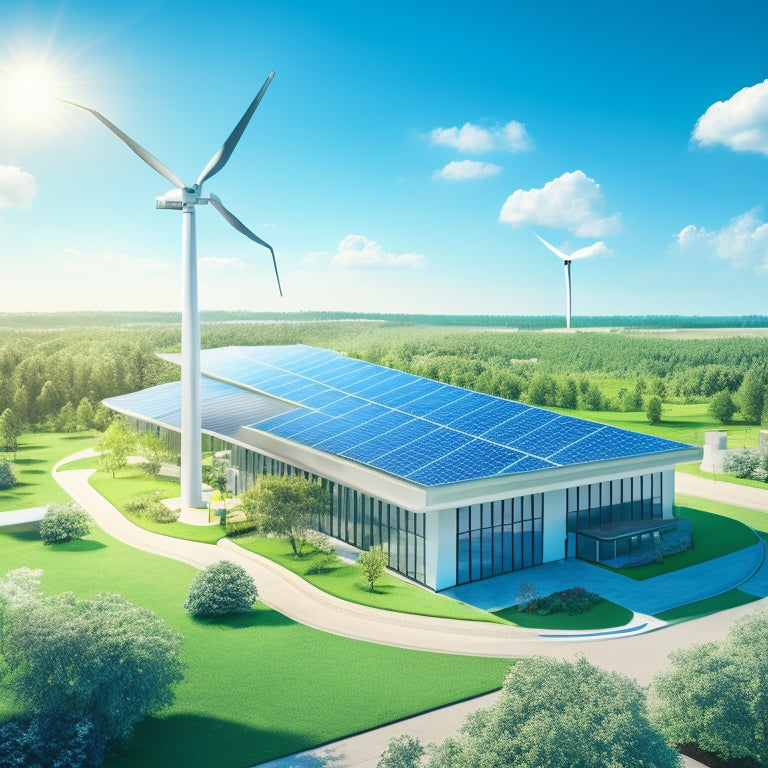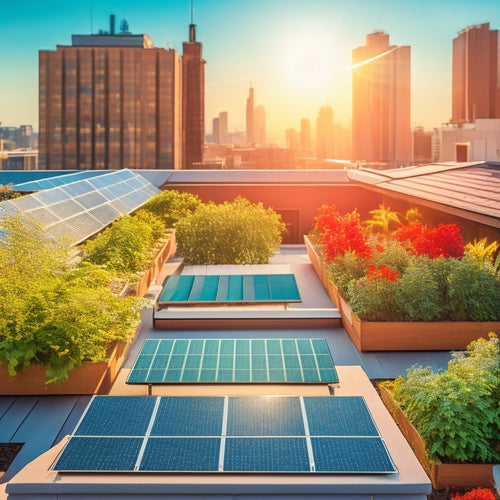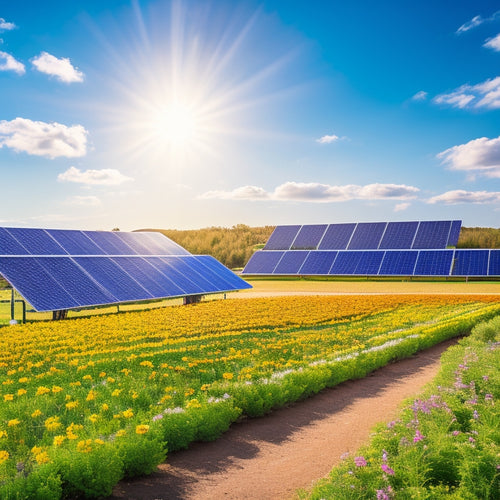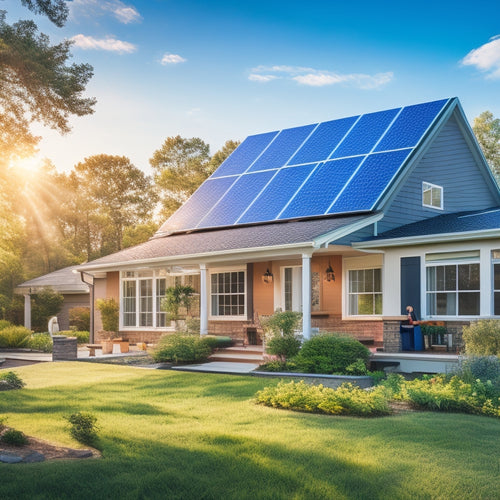
Financing Options for Commercial Properties Going Green
Share
When shifting towards sustainability, financing options abound for commercial properties. Leasing solar panels or securing loans can spread costs over manageable periods, making renewable energy more accessible. Government incentives like tax credits, grants, and rebates can offset costs, while Power Purchase Agreements provide fixed electricity rates. Energy Efficiency Mortgages and Green Bonds offer favorable terms for eco-friendly projects. For a deeper understanding of these financing options and how to navigate the move to sustainable energy, explore the various avenues available to support your eco-friendly endeavors.
Key Takeaways
• Commercial solar panel leasing options allow businesses to spread costs over 7-20 years, reducing upfront expenses.
• Government incentives, such as tax credits and grants, can help finance green energy projects, offering up to $500,000 in funding.
• Solar panel loan financing options provide term loans, construction-to-permanent loans, and solar-specific loans to cover up to 90% of project costs.
• Power purchase agreements enable businesses to purchase electricity at lower rates than utility rates, mitigating maintenance and repair risks.
• Financing options for green building initiatives include energy efficiency mortgages, green bonds, and PACE financing, which provide better terms and incentives for environmentally friendly projects.
Commercial Solar Panel Leasing Options
When shifting to renewable energy, commercial property owners can explore commercial solar panel leasing options, which allow them to harness the power of the sun without shouldering the upfront costs of purchasing and installing solar panels.
As you consider leasing, you'll want to examine the lease duration, which typically ranges from 7 to 20 years. This timeframe allows you to benefit from the solar panels' energy production while spreading the costs over a manageable period.
Additionally, confirm the leasing agreement includes extensive insurance coverage, protecting you from potential equipment failures or damages. By carefully reviewing these terms, you can make an informed decision and take control of your move to renewable energy.
Government Incentives for Green Energy
You can greatly lessen the financial burden of shifting to green energy by leveraging government incentives, which offer attractive tax credits, grants, and rebates to commercial property owners who invest in renewable energy systems. These incentives can substantially reduce the upfront costs of installing solar panels or other green energy systems, making it more feasible to switch to a sustainable energy source.
| Incentive Type | Description |
|---|---|
| Tax Credits | 30% of eligible expenses, dollar-for-dollar reduction in tax liability |
| Grant Funding | Competitive grants for renewable energy projects, up to $500,000 |
| Rebates | Utility company rebates for energy-efficient upgrades, up to $50,000 |
| State Incentives | Varying incentives offered by individual states, such as property tax exemptions |
| Federal Incentives | MacRS depreciation, allowing for accelerated depreciation of renewable energy systems |
Solar Panel Loan Financing Options
How do you plan to finance the upfront costs of installing solar panels, which can range from $50,000 to over $1 million, depending on the size of your commercial property?
You have several solar panel loan financing options available:
-
Term Loans: Repayable over 5-7 years, these loans can cover up to 90% of the project cost.
-
Construction-to-Permanent Loans: Combine construction and permanent financing into one loan, reducing closing costs.
-
Solar-Specific Loans: Offered by banks and specialty lenders, these loans take into account the value of solar credits.
- Loan Insurance: Protect your investment with insurance that covers loan payments in case of project delays or technical issues.
These options can help you overcome the financial hurdles of going green.
Power Purchase Agreements Explained
Solar panel installations can be financed through alternative means, such as power purchase agreements (PPAs), which allow property owners to host a solar panel system without incurring upfront costs.
With a PPA, you'll enter into a long-term contract with a solar developer, typically spanning 10-20 years. You'll purchase the electricity generated by the system at a predetermined rate, usually lower than your current utility rate. This arrangement provides risk mitigation, as you're not responsible for system maintenance or repairs.
When negotiating a PPA contract, it's essential to carefully review the terms, ensuring you understand the duration, pricing, and termination clauses. Effective contract negotiation will help you optimize your energy savings and minimize potential risks.
Financing Green Building Initiatives
Several financing options are available to support green building initiatives, including energy-efficient mortgages, which can provide better loan terms and higher borrowing limits for properties with environmentally friendly features.
As you consider financing options, you'll want to explore the following:
-
Energy Efficiency Mortgages: These mortgages offer better loan terms and higher borrowing limits for energy-efficient properties.
-
Green Bonds: These bonds are specifically used to finance environmentally friendly projects, such as green building initiatives.
-
Property Assessed Clean Energy (PACE) Financing: This financing option allows you to fund energy-efficient upgrades through property taxes.
- State and Local Incentives: Many governments offer incentives, such as tax credits or rebates, for green building initiatives.
Frequently Asked Questions
What Are the Benefits of Hiring a Professional to Install Solar Panels?
When you hire a professional to install solar panels, you'll get a workmanship guarantee, ensuring a flawless installation, and warranty options that protect your investment, giving you peace of mind and long-term savings.
Can I Sell My Excess Energy Back to the Power Grid?
You can sell excess energy back to the grid through a grid connection, earning renewable credits, which can be sold or used to offset your energy bills, giving you control over your energy production and savings.
How Long Does It Typically Take to See a Return on Investment?
"Imagine your wallet smiling, overflowing with cash like a piñata burst open. Seriously, you'll typically see a return on investment within 5-7 years, thanks to significant Cost Savings and accurate Financial Projections, giving you control over your expenses."
Are There Any Tax Implications for Businesses Going Green?
When you invest in green initiatives, you'll benefit from tax incentives like Green Incentives and Carbon Credits, which can greatly reduce your tax liability, allowing you to recoup your investment faster.
Can Existing Buildings Be Retrofitted for Energy Efficiency?
You're likely aware that 75% of commercial buildings in the US are over 20 years old, ripe for retrofitting. When retrofitting existing buildings for energy efficiency, you'll face challenges like outdated infrastructure and high upfront costs, but a thorough energy audit can help you prioritize and optimize your efforts.
Related Posts
-

Solar System Installation Rebates and Tax Credits
Solar system installations offer beneficial rebates and tax credits that greatly cut your initial costs. You can bene...
-

High-Performance Solar Solutions for Sustainable Living
High-performance solar solutions are your gateway to sustainable living, maximizing energy efficiency while considera...
-

Solar Energy Grants and Incentives for Homeowners
Maneuvering solar energy grants and incentives is essential for reducing your installation costs. You can benefit fro...


